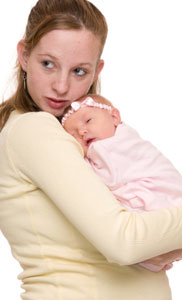Q&A: Understanding the Link Between Low Literacy and Teen Motherhood
 You may have seen the headlines last fall: Researchers from the University of Pennsylvania found that girls with below-average reading ability went on to become teen mothers nearly twice as often as girls with average reading ability. The finding was presented at the American Public Health Association’s annual meeting last year and will be published in the paper “Pre-Teen Literacy and Subsequent Teenage Childbearing in a U.S. Population,” forthcoming in the February 2013 volume of the journal Contraception.
You may have seen the headlines last fall: Researchers from the University of Pennsylvania found that girls with below-average reading ability went on to become teen mothers nearly twice as often as girls with average reading ability. The finding was presented at the American Public Health Association’s annual meeting last year and will be published in the paper “Pre-Teen Literacy and Subsequent Teenage Childbearing in a U.S. Population,” forthcoming in the February 2013 volume of the journal Contraception.
We wanted to know more, especially about what the correlation between low literacy and teen parenthood means for youth workers. So we talked to co-writers Dr. Ian M. Bennett and Dr. Rosemarie Frasso, who studied years’ worth of data from Pennsylvania state databases and the U.S. Census for their paper.
NCFY: What led you to study the connection between literacy and childbirth, and what did you find?
Bennett: Our goal was to bring the perspectives of educators and health care providers together.
Frasso: Public health is a great venue for educators and social workers to look at issues and imagine what the benefits for earlier intervention would be. So while it would be wonderful to read earlier because reading helps you in many different aspects of life and education, another thing you see here is that reading may actually protect them from early childbearing, which leads to other poor outcomes for both the mom and the kid.
Bennett: We looked at a person’s reading skill before they could get pregnant, and then measured their risk basis over seven years, through the rest of their teens. We did the first reading skill assessments at age 11. We found a very strong independent association between their reading skill and their risk of getting pregnant.
NCFY: And why is that?
Bennett: It’s very well shown that kids who have lower reading skills are more likely to drop out of school. Around fourth grade, we make the switch from teaching a kid how to read to needing them to read in order to do the work. “Reading to learn rather than learning to read,” as they say.
So if someone is in fourth grade and they can’t read well, they are being forced every day to come to a setting where they are seen as failures. Choosing to have a child is very much what you would predict for kids who aren’t succeeding in school—seeking a path where they can get out of a context where they have to fail every day.
NCFY: So what are your recommendations for breaking young people out of this cycle?
Bennett: We’ve found that while having one child is risky, what’s worse is having two children or not finishing high school. Those are the two factors that make it much less likely a kid will be independent in their twenties and thirties. So we recommend educators and youth workers do what they can to prevent that second childbirth and keep young people in school.
Frasso: Another important piece is targeting people for interventions. If you know that poor readers are at an increased risk for childbearing in their teens, we want to make sure that information is shared with them about how to postpone childbearing, in a form they can consume. Literacy is going to be a barrier to that information. If we know that about a group, we have to make sure the programs are available to those at greatest risk.


 Sign up
Sign up Follow us
Follow us Like us
Like us Sign up for our RSS feeds:
Sign up for our RSS feeds: 

